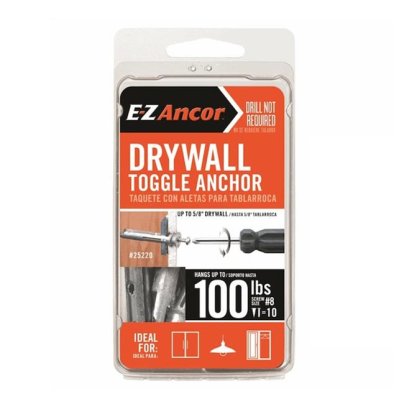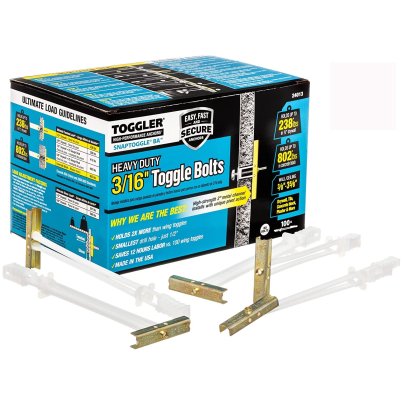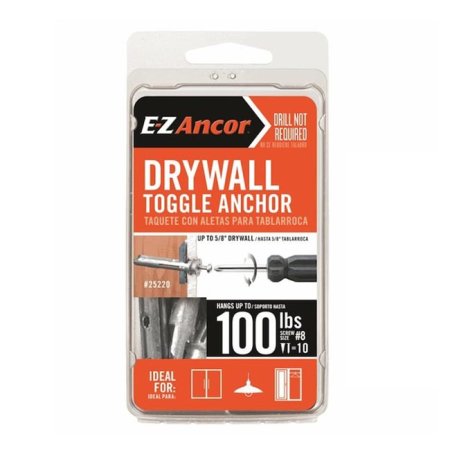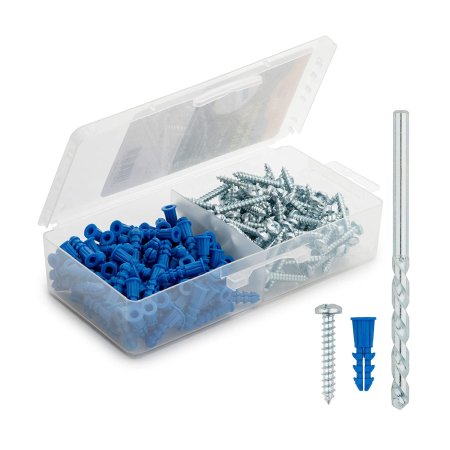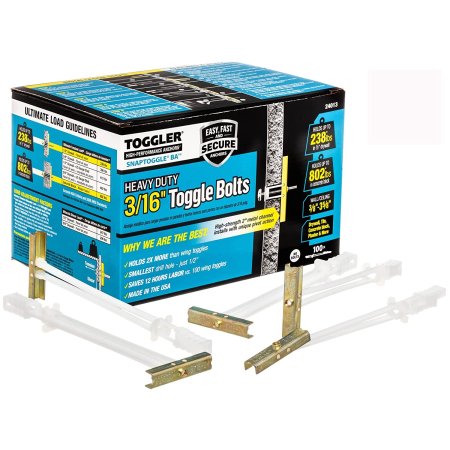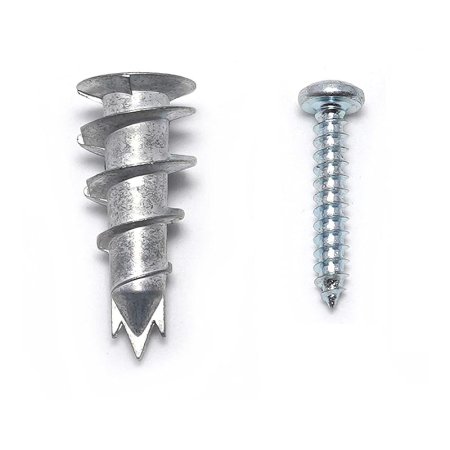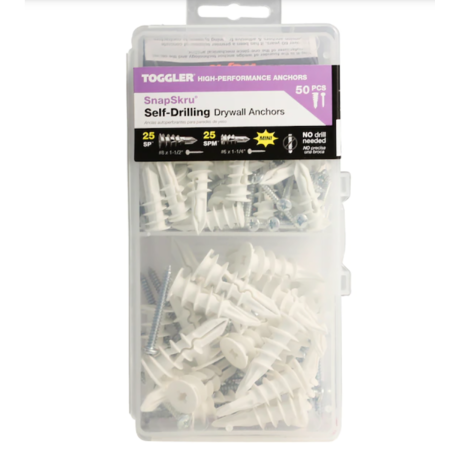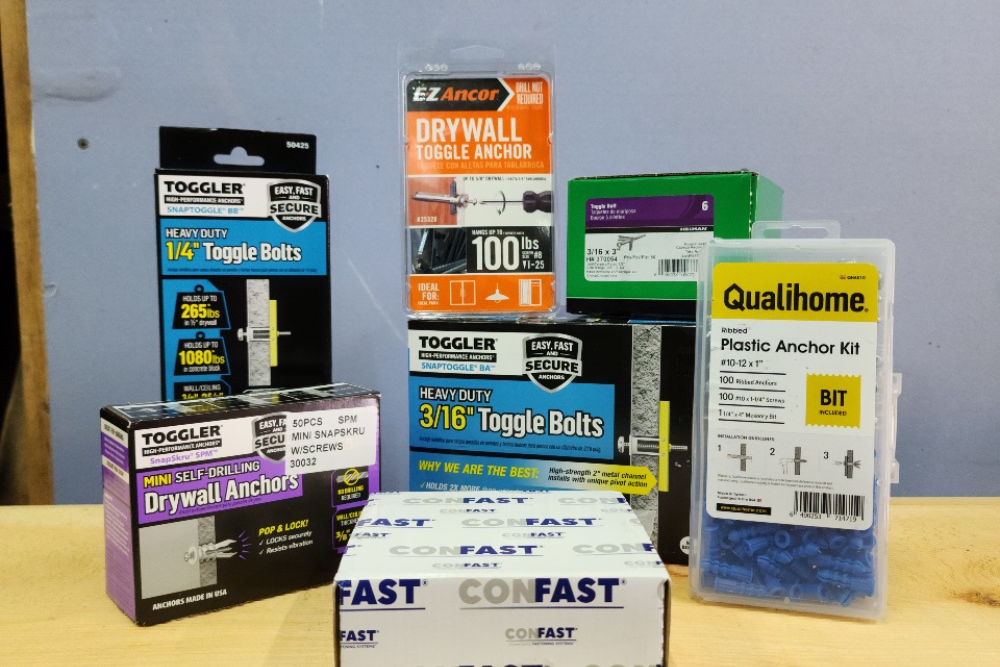
We may earn revenue from the products available on this page and participate in affiliate programs. Learn More ›
Drywall—composed of compressed gypsum (a soft sulfite mineral)—creates wonderfully smooth walls. Yet insert a nail or screw into it, and it’s likely to crumble, often resulting in the fastener working loose and the hung item falling to the floor. The solution is to use drywall anchors, which spread within or behind the drywall panel, creating pressure that locks the anchor in place.
There are four types of drywall anchors, distinguished mainly by how much weight they can hold. Rather than picking up a random drywall anchor, think carefully about the amount of support needed to hang the intended item on the wall. To further understand how to choose one anchor over another, see the results of our hands-on tests. We installed several popular options and loaded them with weight to determine which ones were the easiest to install and offered the most support. We found the best drywall anchors to be the E-Z Ancor Toggle Lock Drywall Anchors thanks to their simple installation and impressive 100-pound weight capacity.
- BEST OVERALL: E-Z Ancor Toggle Lock Drywall Anchors
↓ Jump to Review - BEST BANG FOR THE BUCK: Qualihome Ribbed Plastic Drywall Anchor Kit
↓ Jump to Review - UPGRADE PICK: Toggler Snaptoggle BA Heavy-Duty Toggle Bolts
↓ Jump to Review - LIGHT-DUTY PICK: ConFast Zinc Self-Drilling Drywall/Hollow-Wall Anchor
↓ Jump to Review - MEDIUM-DUTY PICK: Toggler SnapSkru Self-Drilling Drywall Anchors
↓ Jump to Review - HEAVY-DUTY PICK: Toggler Snaptoggle BB Heavy-Duty Toggle Bolts
↓ Jump to Review
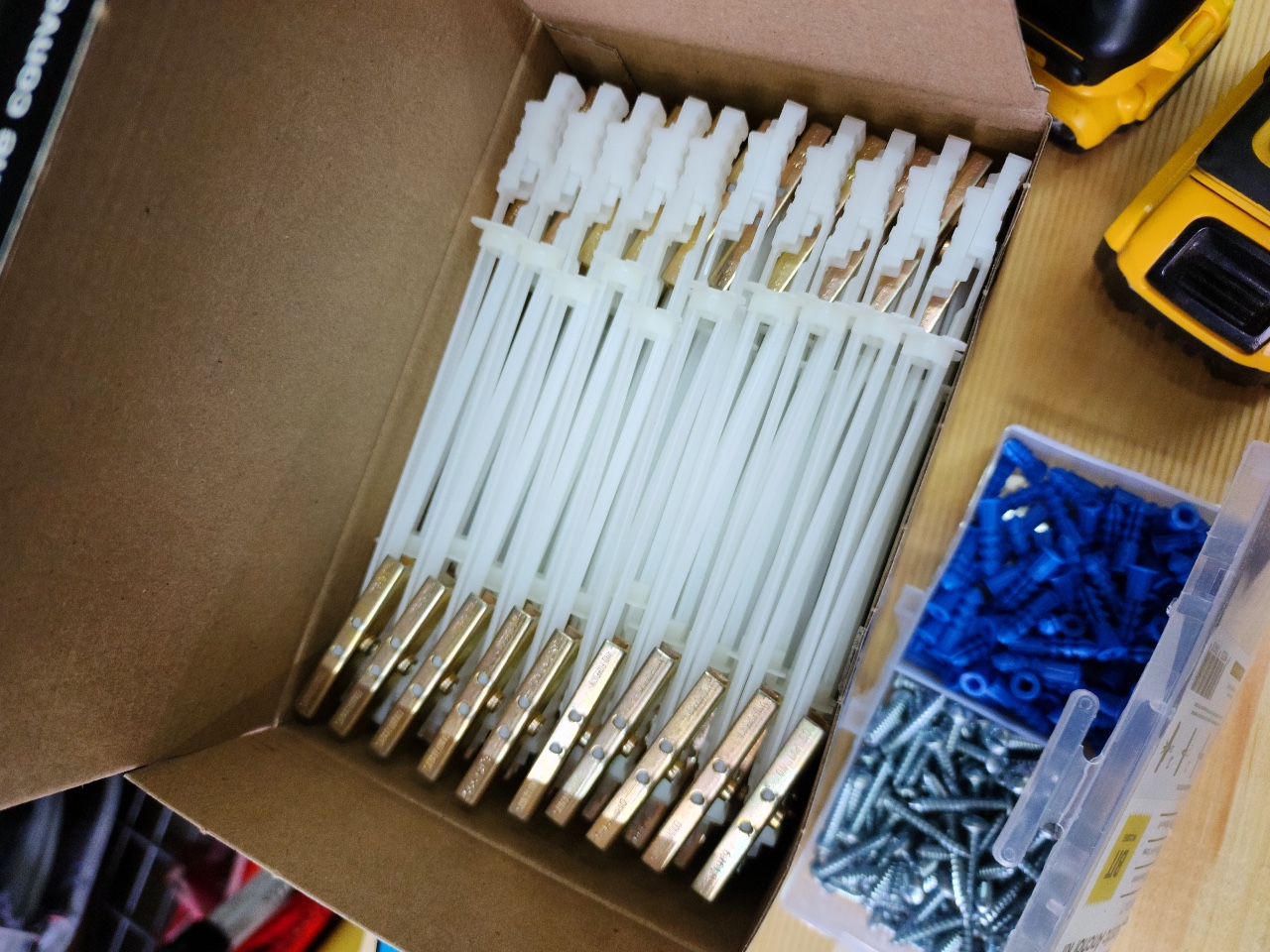
How We Tested the Best Drywall Anchors
There is quite literally a lot hanging on a good drywall anchor, so we wanted to make sure we took our tests as far as they could safely go.
In choosing which anchors to test, we drew upon our experience using and installing drywall anchors and determined the most important features they should have. Then we picked out the different types of anchors a DIYer would use, rounded them up, and put them through testing.
To test the wall anchors for drywall against the manufacturers’ claims (and each other), we screwed a sheet of drywall onto a heavy-duty wooden shelving unit and installed the individual anchors. We noted how easy they were to install or if there were any issues. We created a custom hook to hang from each anchor and then added weight plates to test the anchors’ ability to hold the weight they’re rated for (or aren’t rated for, in some cases). Those that passed got an award based on their strengths, and we left those that failed off the list.
| Testing Stats | |
| Products tested | 7 |
| Time spent testing | 5 hours |
| Tests performed | 5 to 6 |
| Price range | $15 to $60 |
Our Top Picks
Our top drywall anchor picks consistently excel in home use and are favorites among DIYers. Unless otherwise noted, holding powers listed are for standard ½-inch-thick drywall. To ensure these anchors are the real deal, we performed hands-on testing with each of the following products.
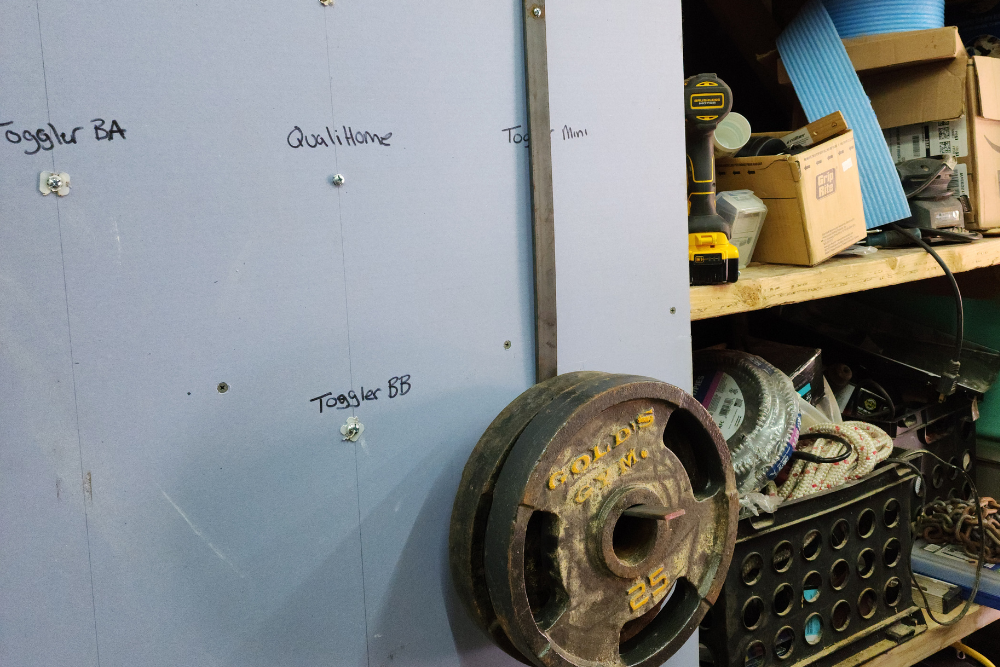
Best Overall
E-Z Ancor Toggle Lock Drywall Anchors
Our Ratings: Ease of Use 4.8/5; Performance 5/5; Value 5/5
Product Specs
- Type: Toggle bolt
- Wall weight rating: 100 pounds
- Quantity: 10
What We Like
- Easy to install thanks to its smart design, even when using a screwdriver instead of a screw gun
- Holds up to 100 pounds, which is substantial for a self-drilling anchor
- Rust-resistant zinc means moisture behind the wall won’t become a safety issue by causing the anchor to fail
What We Don’t Like
- Arrows on the anchor can be difficult to see and need careful alignment to ensure proper installation
E-Z Ancor offers an interesting hybrid that combines the straightforward installation of self-drilling anchors with the strength of toggle-bolt drywall anchors. Their strong metal body cuts through the drywall without needing a predrilled hole, then the toggle pivots and secures in place with the included Phillips-head screw.
To be honest, we aren’t always big fans of self-drilling anchors because they often break during installation. However, the E-Z Ancor drywall anchors are very heavy duty and bore through drywall without an issue, even without a screw gun. Once we popped the screw all the way through the anchor, the bar flipped over and started to tighten, at which point it felt very secure.
E-Z Ancor rates these toggles for up to 100 pounds, which is a lot of holding power from a self-drilling anchor. The pack includes 10 anchors and screws. Because of the zinc plating, they are highly resistant to rust and an ideal choice for use with moisture-resistant drywall in bathrooms and other damp areas.
It is important that the user pay attention to the small arrows on the anchor to line them up, and we felt this is one place that the E-Z Ancor could improve upon—those arrows are small. However, these anchors held all the weight we could safely hang from them, and we liked their hybrid design.
Get the E-Z Ancor drywall anchors at Lowe’s or The Home Depot.
Best Bang for the Buck
Qualihome Ribbed Plastic Drywall Anchor Kit
Our Ratings: Ease of Use 5/5; Performance 4.5/5; Value 5/5
Product Specs
- Type: Expansion
- Wall weight rating: Not stated
- Quantity: 100
What We Like
- Kit includes a drill bit, which can also be used to install these anchors in masonry
- Very affordable option; a smart buy for light-duty situations
- Large quantity offers convenience for users hanging multiple items
What We Don’t Like
- Manufacturer doesn’t list weight capacity; consider multiple anchors for anything over 15 pounds
For reliable support in light-duty situations, consider the Qualihome ribbed plastic drywall anchor kit. It comes with 201 pieces (100 pairs of plastic anchors and screws plus a drill bit), so users will have plenty of anchors on hand. The anchor shanks are split, allowing them to expand (with screw insertion) for snug attachment.
The packaging doesn’t state the product’s weight capacity, but we estimated the weight capacity at around 25 pounds during our tests. To be on the safe side, stick to applications like hanging pictures and small mirrors or attaching small towel or robe hooks.
We appreciate that the kit comes with a drill bit, which is designed to work with masonry or tile surfaces as well as drywall. Obviously, the lower weight capacity is an issue, but for the price, the Qualihome kit is worth considering.
Get the Qualihome drywall anchors at Amazon.
Upgrade Pick
Toggler Snaptoggle BA Heavy-Duty Toggle Bolts
Our Ratings: Ease of Use 5/5; Performance 5/5; Value 4/5
Product Specs
- Type: Toggle bolt
- Wall weight rating: 238 pounds
- Quantity: 100
What We Like
- Anchors stay put when installed, making installing brackets and other multibolt items easier
- Each toggle has a weight capacity of 238 pounds, allowing these anchors to hold heavy items
- They require a much smaller hole than other anchors with a similar weight capacity
What We Don’t Like
- The kit didn’t come with any bolts, so we had to steal some from another anchor set.
Folks who want a heavy-duty toggle that won’t fall back into the wall every time they remove a bolt will want to consider Toggler Snaptoggle. This anchor features long plastic tabs that help the user align the anchor. To lock the anchor in place, simply hold these tabs in the drilled hole and pull on the straps. The user can then break the tabs off, and the anchor remains in place for multiple uses.
Each of the 3/16-24 bolts and anchor combos in the BA kit can handle up to 238 pounds in ½-inch drywall. They’re suitable for supporting TVs, large paintings and mirrors, and other heavy items on drywall without issue. In some cases, they can even be used to anchor bookshelves in place.
We loved the Snaptoggle. They’re the easiest heavy-duty toggle to use, and the fact that they don’t fall into the wall when the bolt is removed is a huge benefit. This is a plus when hanging items like TV brackets, which often require three or four toggles. We also liked that this anchor only requires a ½-inch hole, whereas another anchor with a similar holding capacity would require a much larger hole. Our biggest complaint is that the kit doesn’t come with bolts, so we had to steal some from another kit.
Get the Toggler Snaptoggle BA drywall anchors at Amazon, Lowe’s, or Walmart (10-pack).
Light-Duty Pick
ConFast Zinc Self-Drilling Drywall/Hollow-Wall Anchor
Our Ratings: Ease of Use 4/5; Performance 4/5; Value 4/5
Product Specs
- Type: Self-drilling
- Wall weight rating: 50 pounds
- Quantity: 100
What We Like
- Metal design is more durable and easier to install than most plastic self-drilling anchors
- Easy to remove but also easy to reuse if the screw wasn’t overtightened
- No predrilling or power tools needed to install—a screwdriver will do the trick
What We Don’t Like
- Overtightenting the screw can cause the anchor to back out when removing the screw in the future
Self-drilling anchors are popular for their ease of installation, but plastic models can be prone to breakage during insertion. However careful a person is, it is highly probable that some anchors will be wasted. ConFast’s solution is offering a stronger metal version with a deep thread to provide added grip. This increased strength also means they are much more likely to be reusable.
The ConFast self-drilling drywall anchor is zinc plated to prevent rust. They’ll hold up to 50 pounds and can be used with various drywall thicknesses. The pack has 100 anchors and screws, and they work with ⅜-, ½-, and ⅝-inch drywall.
We used hand tools to install these anchors, as that’s what they’re truly designed for. They cut through the drywall well, and the sharp points didn’t break off as is common with plastic alternatives. We loaded this anchor with the rated 50 pounds, and it held it without an issue. These anchors are reusable, but we found that if we tightened the screws down too much, they did start to back out when we removed the screws.
Get the ConFast drywall anchors at Amazon.
Medium-Duty Pick
Toggler SnapSkru Self-Drilling Drywall Anchors
Our Ratings: Ease of Use 5/5; Performance 5/5; Value 4.5/5
Product Specs
- Type: Self-drilling
- Wall weight rating: 65 to 79 pounds
- Quantity: 50
What We Like
- Installation does not require drilling a hole or a drill at all—a screwdriver will do
- Each plastic toggle has a weight capacity of 65 to 79 pounds, which is considerably higher than most plastic anchors
- These anchors are reusable if screws are taken out slowly and carefully
What We Don’t Like
- Using a power drill to install these toggles will break them
Plastic self-drilling anchors are usually nothing more than a pain. But with the Toggler SnapSkru self-drilling drywall anchors, that’s not the case. Manufactured from glass-filled nylon, Toggler SnapSkru self-drilling drywall anchors are rigid enough and sharp enough to screw into drywall without predrilling a hole, and they don’t require a drill—a screwdriver will do.
DIYers will benefit from SnapSkru’s ease of use, particularly their hefty holding power. The 50-pack of threaded anchors contains two sizes, regular and mini, each with 25 anchors and 25 screws. The regular anchors are rated for up to 79 pounds, while the minis hold 65 pounds in ½-inch drywall.
We’re Toggler fans, but we don’t like self-drilling anchors, especially when they’re plastic. To our surprise, we did like these! They didn’t fail when installed with a screwdriver, though the power drill (which they are not designed for) proved too much. We also liked that they had such a high weight capacity for a plastic anchor, with the minis easily handling 65 pounds of weight.
Get the Toggler SnapSkru drywall anchors at Lowe’s.
Heavy-Duty Pick
Toggler Snaptoggle BB Heavy-Duty Toggle Bolts
Our Ratings: Ease of Use 3.8/5; Performance 5/5; Value 4/5
Product Specs
- Type: Toggle bolt
- Wall weight rating: 265 pounds
- Quantity: 10
What We Like
- Holds up to 265 pounds in ½-inch drywall; suitable for TV brackets or holding shelving units in place
- They won’t fall behind the wall like spring toggles, allowing for reuse time and time again
- Require a much smaller hole (just ½ inch) than other commercial anchors with similar weight ratings
What We Don’t Like
- Anchor must be flush against the wall or bolt won’t thread into the anchor
When it comes to heavy-duty hanging, be sure to consider the Toggler Snaptoggle BB heavy-duty toggle bolts. These bolts feature the brand’s plastic tab and zip straps, allowing users to drill the hole, install the anchor, and zip it into place for secure mounting. And, unlike winged toggles, these anchors stay in place when the bolt is removed. This allows these anchors to be reusable time and time again.
This kit comes with ten anchors and ten ¼-20 bolts for installing them. They hold up to 265 pounds in ½-inch drywall or 1,080 pounds in concrete block. These anchors are suitable for TV brackets or holding standing bookshelves to the wall. They require only a ½-inch hole for installation.
These toggles were one of our favorites on the list. First, they come with bolts, so we didn’t have to steal any. Also, we liked that they’re held in place rather than falling behind the wall, making it easier to install items with multiple bolts rather than trying to align each anchor at once. They also required a much smaller hole than an anchor of similar capacity. It’s important to note, however, that if the anchor isn’t sitting flush against the wall, threading the bolt into the anchor is difficult.
Get the Toggler Snaptoggle BB drywall anchors at Amazon.
ALSO TESTED
Hillman 370054 Round Head Machine Screw Toggle Bolts
The Hillman 370054 toggle bolts didn’t malfunction during testing, but they’re a pain to use. To install a toggle, we had to drill a hole, thread the bolt, toggle through the item being hung, and then install the toggle into the hole. When we removed the bolts, the toggle fell, making them impossible to reuse. Also, the weight-rating information for the Hillman 370054 toggle bolt is confusing. Some sources say that they hold 85 pounds, others state 55 pounds, while still others claim only 40 pounds. And somehow no clarifying information is available from Hillman. We unknowingly overloaded ours with 100 pounds in testing, but who knows if that’s safe? Overall, there are too many options that are easier to use and that provide accurate weight ratings to consider this a worthy anchor for our best-of list.
Jump to Our Top Picks
What to Consider When Choosing Drywall Anchors
Choosing the right type of drywall anchor is a key factor in ensuring the item being affixed is secure, but some other things also impact the decision.
Types of Drywall Anchors
There are four main types of drywall anchors (also called hollow-wall anchors), and each has its pros and cons. It’s important to understand how each type performs to choose the right one for the job. Ease of installation, strength, and cost each has an impact, and each of these is discussed in the following section.
Expansion Drywall Anchors
True to their name, expansion anchors spread to create a tight bond with the wall and are designed to hold lightweight items. The anchor’s shank (tapered end) is split in half. To install, drill a pilot hole in the wall, fit the anchor into the hole, and use a hammer to lightly tap the anchor head flush with the wall. Then insert a screw into the anchor, and the split ends of the shank will spread and expand to put pressure on the inside of the drywall and hold the anchor securely.
Expansion anchors are:
- Often made of plastic but may also be made of nylon or zinc-coated metal;
- Affordable, averaging $.03 to $.20 per anchor, depending on size;
- Easy to install and DIY-friendly;
- Able to hold between 5 and 25 pounds, depending on brand and size, with larger anchors holding more weight; and
- Not suitable for use on ceiling drywall because downward pressure can cause the anchor to slip out.
Threaded Drywall Anchors
Also called “self-drilling drywall anchors” or “self-tapping anchors,” threaded drywall anchors are made of hard nylon or metal and can hold heavier items. They feature sharp, pointed shanks that can be screwed into the wall without a predrilled hole by using a screwdriver or a screw gun. Once the anchor is in the wall, the screw is inserted. With nylon versions, this forces the sides of the anchor to flare and wedge the anchor tightly against the drywall. Metal versions rely on a deeper thread for grip.
Threaded drywall anchors are:
- Able to hold 25 to 75 pounds, depending on their size;
- Self-drilling with no pilot hole necessary;
- Relatively inexpensive at $.25 to $.40 per anchor, depending on brand and size;
- Easy to install with a screwdriver or screw gun; and
- Not suitable for use on ceilings.
Molly Bolts
Known as “molly bolts” or simply “mollies,” these metal sleeve-type hollow wall anchors provide medium-weight holding power but offer a unique feature in that users can remove the screw and reinsert it if necessary in the future.
Here’s how it works: A pilot hole is drilled into the drywall, and then the anchor is inserted into the hole. The underside of the anchor’s head features sharp metal tips that pierce the drywall surface. When the screw is inserted in the anchor, each twist of the screw forces the shank of the anchor to compress (lengthwise) while it expands sideways. When correctly inserted, the screw can be removed from the anchor (which remains securely in the wall) and reinserted. This makes it handy if DIYers replace items such as toilet paper holders in the same spot.
These anchors:
- Have a holding power of 25 to 55 pounds, depending on size;
- Require a predrilled hole;
- Have a permanently attached shank, but the screw can be removed;
- May be used in ceiling drywall for lightweight items, such as smoke alarms; and
- Cost $.25 to $.40 per anchor, depending on brand and size.
Toggle Bolts
When users need heavy-duty holding power, they will want to opt for toggle anchors, which come in various sizes, designs, and materials, including metal and plastic.
Traditional metal toggle bolts are the strongest of the bunch, but they’re not the simplest to install because they require drilling a hole approximately three times wider than the diameter of the bolt (necessary to insert the anchor). With these, the anchor features one or two bars (or wings) that fold flat against the bolt during insertion. Once inserted, a quick twist of the bolt loosens the wings, causing them to flare outward. As the bolt is tightened with a screwdriver, the wings draw inward to form a strong perpendicular brace along the back side of the drywall. The installation challenge is keeping the bolt centered in the hole while tightening it. It takes some practice and patience for users to get it right, but once they do, they’ll be impressed by the strong holding power. There’s more likelihood of the wall itself failing before the toggle bolt does.
Winged plastic anchors (the new kids on the block) feature plastic “wings” that fold tightly together so the anchor can be inserted into a predrilled hole. Once the anchor is in place, a wand (included with the anchor) is pushed through the hole to expand the wings on the back side. A screw is then inserted, which draws the wings snugly against the back of the drywall.
Toggle bolts have:
- A maximum holding power of 100 pounds (for metal toggles, depending on size) or up to 20 pounds (if plastic winged, depending on size);
- Capacity to be used on ceilings at a third of the holding power listed for walls, up to a maximum of 15 pounds (drywall may pull away from ceiling joists at heavier weights); and
- Difficulty staying level during installation.
Weight Limit
Drywall anchors come in various designs and sizes, each with different holding power, a measure of the maximum weight they can support. Although manufacturers are not required to list their anchors’ holding power, many do, either on the package or in the included literature. Some basic drywall anchor types are associated with a range of holding power. For an in-depth discussion of holding power, please see the A Word About Weight Capacities section below. Always use an anchor with a holding power that meets or exceeds the weight of the item to be hung.
Screw and Bit Size
Drywall anchors can be purchased separately from the screws they hold in place. However it’s wise for consumers to buy anchors that come packaged with the screws to ensure they’re the correct size. If purchasing anchors and drywall screws separately is preferred, DIYers can find the required screw size on the package. If the type of anchor selected requires a predrilled pilot hole (sometimes recommended with self-drilling drywall anchors), the corresponding drill-bit size is often listed on the package.
A Word About Weight Capacities
Most drywall anchors are rated for shear strength, which is the vertical weight that pulls the anchor straight down. This measurement is useful in scenarios like hanging a picture, mirror, or even an armless TV bracket. In these situations, gravity pulls the weight downward, and the anchors are able to perform close to their weight rating.
However, when using anchors to install floating shelves, swinging TV brackets, and other items that stick out from the wall, it’s important to consider leverage. An anchor may be rated for 50 pounds, but 20 pounds of weight on the end of an 8-inch shelf will produce 160 inch-pounds of torque, which will likely break that 50-pound anchor.
Considering such calculations can be a bit of a trip back to high school geometry class, but it’s important to recognize that leverage impacts weight rating. For this reason, it’s better to go with an anchor rated for much more than the object’s weight.
FAQs
There is a lot of useful information in the article above to help consumers choose the best drywall anchors for a variety of different tasks. That said, during our research we came across several general questions that cropped up frequently. For convenience, we have covered those here.
How someone installs drywall anchors depends on the type. Self-drilling anchors are the easiest to use because they create their own hole. Others need a hole to be drilled prior to installation. The drill bit for this may be provided with the fixings, but that’s not always the case.
The weight a drywall anchor can hold varies enormously. Lightweight plastic drywall anchors can support 10 or 15 pounds, whereas the strongest bolts can support more than 200 pounds. However, it is generally recommended that only a quarter of the maximum weight is used per anchor. Sometimes two or more drywall anchors should be used (for shelves, for example), so DIYers will want to do some math to find a fixing with the appropriate capacity.
No. DIYers would create too large a hole, thus ruining the grip or breaking the drywall. Users can give self-drilling types a light tap with a wooden or rubber mallet to get the point embedded up to where the thread starts. They can also tap in expansion-type drywall anchors, but only after the correctly sized hole has been drilled.
How consumers remove drywall anchors depends on the anchor type.
– Self-drilling plastic wall anchors can be screwed back out again. The neat hole is easy to fill.
– Ribbed plastic anchors can be removed by inserting a screw and using pliers to pull the combination out. Users might also use a flat-blade screwdriver for extra leverage. Bear in mind the hole left behind can be a little ragged.
– Molly bolts can sometimes be removed by inserting the bolt halfway, then tapping with a hammer to straighten out the flared part in the wall. This isn’t always successful, and it may be easier to knock the whole fixing through into the wall cavity, where it will do no harm.
– With toggle bolts, users just back out the screw and let the winged anchors fall inside.
Certain types of drywall anchors are reusable, so long as they are made from durable materials and are taken out carefully to avoid breakage. Generally, screw-ins and toggle bolts will be reusable, while plastic and self-drilling will be single use only.
This depends on the size and type of the screw you will be using for that drywall anchor. It’s all about the diameter of your screw, and you want to use an anchor that’s slightly smaller than the screw’s diameter so that it gets a tight grip on it as it goes in.
When drilling a pilot hole for your drywall anchors, check the packaging to see what size of drill bit you need to create the ideal hole size for that anchor.
When installing the anchors, you want to make sure they are flush with the wall. It shouldn’t protrude out from the wall, nor should it be deeper than the surface of the wall.
Meet the Tester
Tom Scalisi is a full-time DIY and construction writer for many of the largest websites in the industry, including BobVila.com, This Old House, Family Handyman, and Forbes. He also owns and operates a pest control blog, RiddaBugs.com. He spent years working in industrial building maintenance, installing thousands of hollow wall anchors over time.
Additional research provided by Bob Beacham and Glenda Taylor.
